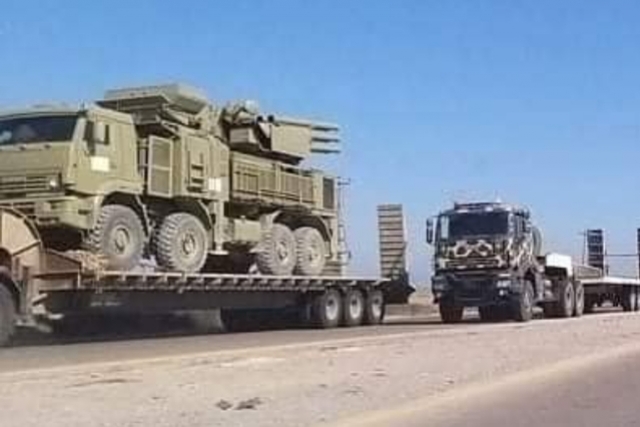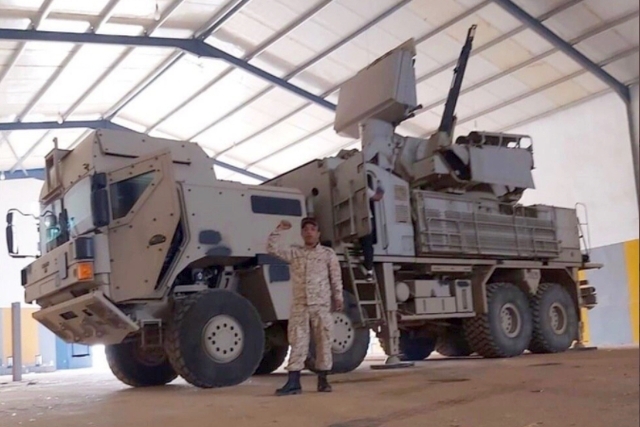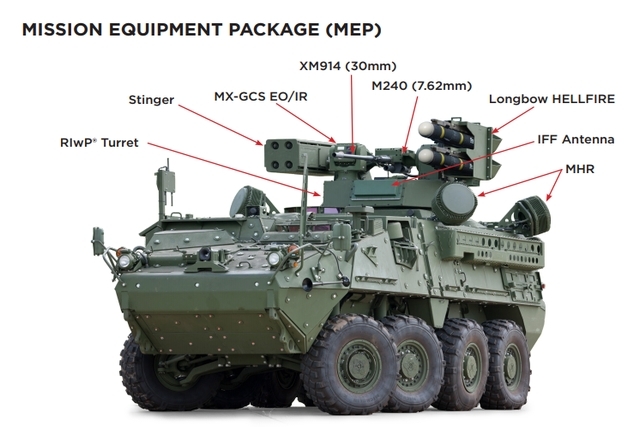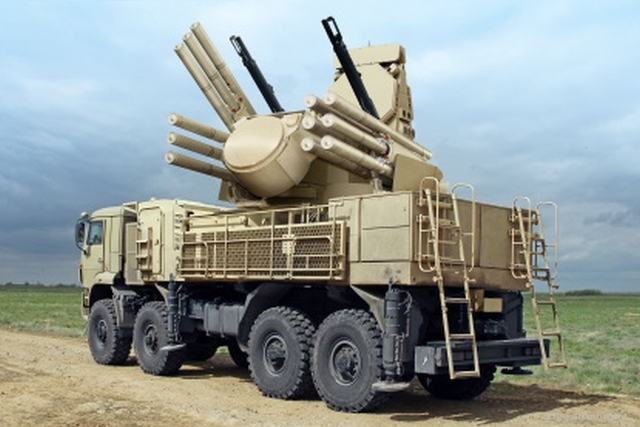Is the Carting Away of Russian Pantsir S1 linked to U.S. Army’s IM-SHORAD Testing?

Russian Pantsir S1 System on the move in Libya; Image via Twitter
Speculation is rife that the U S military moving a Russian-made Pantsir S1 air defence system (ADS) from Libya to Germany may have something to do with the development and testing of the Interim Maneuver, Short-range Air-defense (IM-SHORAD) of the U.S. Army.
In May 2020 reports and photos emerged that an intact Pantsir S1 system was captured by Libyan government forces from the Libyan National Army (LNA) aligned with renegade commander Khalifa Haftar which had received it from the United Arab Emirates (UAE).
British newspaper The Times reported Thursday that in June 2020, a U.S. Air Force C-17A Globemaster III transport aircraft carrying a Pantsir S1 took off from Zuwarah International Airport near Tripoli, and flew to Ramstein Air Base in Germany,
The Times ‘learnt’ that “the operation was ordered amid concerns that the Pantsir S-1 missile battery, which can easily bring down civilian aircraft, could fall into the hands of militias.” However, that objective could have been achieved by simply destroying the system and not taking the trouble to fly it all the way to a U.S. base in Germany.
The Pantsir S1 seized in Libya is said to be the S1E model exported to the UAE, which is the most advanced version of the Russian ADS.

Raising red flags about flying the Pantsir S1 to a U.S. base, U.S. publication, The Drive commented, “There would also be clear intelligence benefits from obtaining a largely intact example of this system, which Russia operates and has also exported widely.”
The U.S. military has not commented on The Times report leading to speculation that the Pantsir S1 may have been taken away as part of testing its own IM-SHORAD. In the past, U.S. military has used Russian equipment procured from former Soviet Bloc nations for testing and comparison with its own military hardware.
In 1997, Washington acquired twenty-one MiG- 29 jets from Moldova which were shipped to the U.S. and exhaustively evaluated there. Later, some of these MiG-29s, flown by German air force pilots were pitched against F 16, F/A 18, and F 15 of the USAF in exercise Red Flag, an annual exercise held with foreign partners.
In Russia, Vice-President of the Academy of Military Sciences (AVN) Sergey Modestov told Interfax news agency on Friday, “The hardware itself is a good find for the United States. The knowledge gained can be used against those who have a similar armor (Pantsir S1).”
Currently under testing, the IM-SHORAD is considered a direct competitor to the Pantsir-S1. Like the Russian system, it provides low altitude defence against drones, aircraft and helicopters. It will be the first system of its kind to be fielded by the U.S. Army.
Soldiers from the 5th Battalion, 4th Air Defense Artillery Regiment out of Ansbach, Germany traveled to the White Sands Missile Range to conduct training and operational testing of the Army’s IM-SHORAD system, a U.S. Army announcement had said in November 2020.
The IM-SHORAD is one of the Army’s solutions to replace the aging Avenger short range air defense system. While the Avenger worked well in its day as a Cold War platform for the protection of Army units from close in air threats, the system is showing its age, being less survivable than other modern air defense systems, and requiring a long set up time to get operational, the announcement said.

“The (US) Army is investing in the interim maneuver, short-range air-defense platform to provide soldiers with 360-degree protection from unmanned aircraft systems and other low-altitude aerial threats,” The then US defence secretary, Mark Esper announced at the Association of US Army event in October 2020 adding, “This system will most likely be integrated into four battalions in Europe in 2023.”
The IM-SHORAD consists of Leonardo DRS’ Mission Equipment Package (MEP) mounted on a General Dynamics Stryker A1 platform to provide soldiers with protection using guns, missiles, rockets and onboard sensors. Earlier General Dynamics had been awarded a $1.2 billion contract to deliver short-range air defense systems to the U.S. Army.
The need for an IM-SHORAD was identified several years ago by NATO as Russia fielded the Pantsir-S1 to defend its S-300 and S-400 long range missile batteries against short range threats.
The Pantsir-S1 went on to become a huge commercial success for Russia with some 11 countries opting for it. Several of these countries procured the Pantsir-S1 and its variants to protect vital installations from air threats.
According to Leonardo DRS, the IM_SHORAD detects, identifies and tracks air threats providing 360 degree aerial surveillance; Defeats ground and air threats using cannon fire and missiles; Defeats smaller air threats (Group 1 and 2 UAS) at closer ranges with direct fire.
The IM_SHORAD’s main weapons are a 30mm cannon besides Hellfire and Stinger missiles guided by a Multi-Mission Hemispheric Radar (MHR).

The Pantsir S1 and its variants are in use with the United Arab Emirates (UAE), Syria, Jordan and Algeria among others. In May 2000, the UAE ordered 50 Pantsir-S1 systems, mounted on MAN SX 45 8×8 wheeled vehicles. The order was worth $734 million.
Syria procured 50 Pantsyr-S1 systems. Jordan has also placed an order for an undisclosed number of systems. The Pantsyr-S1E system for the UAE is fitted with a new MRLS fire control radar. MRLS is a phased array radar, with a range of up to 28km. Algeria’s Pantsir-S2 too is believed to come with an advanced AESA radar.
The most notable battlefield success of the Pantsir-S1 system came in 2018 when a battery of it repelled a drone swarm that attacked the Khmeimim Air Base of the Russian air force in Syria.
Pantsir-S1 carries 12 57E6 missiles on launchers. The missile has a maximum speed of 1,100m a second. The range is between 1km and 12km. Two 2A72 30mm guns are fitted with 750 rounds of a variety of ammunition such as high-explosive, fragmentation and armor-piercing.
The Pantsir-S1 fire control system includes a target acquisition radar and dual waveband tracking radar, which operates in the millimetre and centimetre waveband. Detection range is 30km and tracking range is 24km for a 2cm² to 3cm² target. This radar tracks both targets and the surface-to-air missile while in flight.









